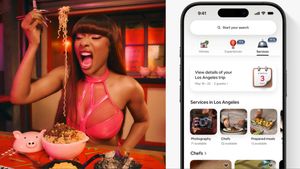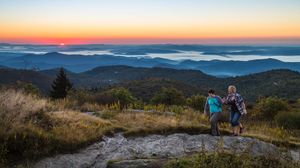It may be facile to suggest that artists are peacemakers, but they can perhaps break us free of blinkered and reductive "us vs. them" thinking. Jordan Nassar's work is rooted in his Palestinian identity, but in subtle and rich ways it also illuminates how identity is built on a constant process of cross-pollination and cultural accumulation. As a Palestinian artist who is married to an Israeli, he has a more nuanced understanding of how distinct communities overlap and synthesize than armchair cynics who see only two peoples anchored in opposition.
Related | Jordan Nassar is Weaving the World Into His Embroidery
He likes to illustrate his point with the case of the Israeli singer Zehava Ben. As a Mizrahi Jew -- the term for emigrants who arrived in Israel from Arab countries like Iraq, Syria, and Morocco -- she sings in an ornamental, melismatic style that is familiar to people throughout the Middle East, but long resented by Israelis with European roots who typically veer toward Western-style pop. As Ben's popularity grew in the late '90s, however, she began to dissolve the old binary. Suddenly, it became possible to hear her music in Tel Aviv nightclubs, rather than just in taxis and street markets -- she even made it onto the first of the modish Buddha Bar compilation CDs. "Here's the crazy thing," says Nassar. "After a couple of albums, she put out a collection of classics, Zehava Ben Sings Arabic, so then you have an Israeli singing in Arabic, and that's acceptable somehow. But the crazier thing is that she starts to become famous in Arab countries for her Arabic recordings." He pauses. "That's something I've kind of addressed through embroidery."
Although conversation around art and representation is often fraught with questions of appropriation, Nassar employs a more generous phrase -- cultural absorption -- to describe the way that European Jews in Israel have inherited traditional aspects of Arab life, like hummus. In a similar vein, he has a cherished book of Eastern European embroidered rose patterns that have influenced Palestinian dress from the mid-1800s as people from Ukraine and Poland began showing up in the Eastern Mediterranean. At that point, the abstracted symbols on Palestinian dress became more figurative. "I took the Ukrainian patterns and embroidered them exactly as they are in the book," says Nassar. "The only thing I added was a section of green." Green is one of the colors of the Palestinian flag. Borrowing from the book title, Antique Ukrainian Rose Patterns, Nassar named the pieces Antique Palestinian Rose Patterns. In this way, his works address a fundamental question: How long does it take for something associated with one culture -- in this case Ukrainian rose patterns -- to be accepted as a legitimate facet of another culture? "So, by extension, it's about hummus," adds Nassar. "Is hummus Israeli yet? How long do they have to eat it before it's Israeli? We talk so much about the whitewashing of cultures, but what if it's not active and violent -- what if it just sunk in?"

At a recent solo show in Los Angeles's Anat Ebgi Gallery, Nassar's work shimmered on the walls, swirls of color resolving themselves into landscapes composed of patterns similar to the embroidered dresses that Nassar takes as his starting point. But pattern and texture is just the beginning. "I don't want to be the embroidery guy," he says. "I'm not a good drawer or painter -- in a way, this is the technique of painting that I've become really good at using and manipulating."
While Nassar admires Anni Albers and Sheila Hicks -- pioneering artists who led the way in using embroidery and weaving as an artistic medium -- he considers himself to be advancing the conversation they began. "The battle for them was about form, texture, and color, but I try to keep that secondary," he says. "The primary thing is other concepts and issues that I try to address, beyond the nature of fiber and yarn."

Yellow is the Sun's Color, 2017
Take, for example, the botanical motifs that adorn his landscapes. In the long history of Palestinian identity, a decorated border of a dress that incorporated, say, an abstract emblem of a date palm would tell you what town the wearer came from, whether it was Bethlehem or Ramallah or Jerusalem. In this way, clothing operated as an atlas of place. However, for Nassar, the son of a Palestinian doctor and a Polish mother, that place is New York.
Related | Meet the Man Who Gave New York a 40-Foot Erection
"In Palestine, each village has symbols they use, but I'm not from any of those villages, so the fundamental question was what symbols does a Palestinian from New York use?" he says. "The really traditional patterns are based on local flora and geographical features, as well as normal household stuff like chickpeas and coffee beans that reflect daily life." So Nassar created a set of symbols based on things familiar to New York's Upper West Side where he grew up, such as the roundabout by the 79th Street Boat Basin that shows up in his work as a white loop. "It is Palestinian embroidery, but it's not from any of the villages you'd recognize," he says. "All of these patterns are made up."

Study (The Sun Runs Away)
There is one exception: Some symbols are historically associated with embroidery from Jaffa, an old Arab port adjacent to Tel Aviv. Nassar stayed in the neighborhood for a transformative artist residency in 2017. Many friends in New York, both Arab and Israeli, his husband included, advised against him accepting the offer. He was told that some of the financing came from people who supported illegal Jewish settlements in Palestine. "I thought a lot about it," says Nassar. "But I felt that boycotting it, and writing a Facebook post to say I was boycotting it, wasn't really doing anything." The program's website was in Arabic, as well as in Hebrew and English, and that impressed him, too. "They chose to be inclusive," he says. They also provided a studio, an apartment, a stipend, and reimbursed his production money -- money he used on trips to the West Bank to purchase embroidery from older women who make a living from their ancient craft. "In that way, I took Israeli money and I gave it to normal Palestinian people trying to feed their families," he says.
In the process, Nassar also discovered that what unites people is often greater than what divides them. "I grew up here, half Arab, half Polish, and basically my whole childhood people were like, 'That's such a crazy mix.' " He laughs. "And then you go to Israel and everyone is half Middle Eastern and half Slavic -- there are Moroccan Jews and Yemeni Jews and Iraqi Jews mixing with Russian Jews, or whatever, so a lot of people look like me."

Study (Orchids in a Porcelain Sky), 2017
And there was the added element of his sexual orientation. "We have enclaves of Arab families in Yonkers, or in upstate New York, that are very Arab -- 10 kids who all speak Arabic, and marry women from Jordan, and bring them over and I never felt comfortable around that side of the family because I was so flamingly gay," he says. "I love being in Palestine, but during the residency, I'd be there for a couple of days, and then be like, 'OK, I want to go back to Tel Aviv now,' because I have to hide my tattoos, and I can't wear any jewelry. It's benign in a way, but a hugely tricky thing for me to navigate emotionally."
Related | This Queer Sculptor Fled Uganda, and Her Art May Save Her Life
If there is a unifying theme in Nassar's story, it's about the relationship between displacement and belonging -- Nassar's own, as well as the broader displacement of Palestinians and Jews, and how they navigate their relationship with the other, and among themselves. His idol is the Lebanese painter and writer Etel Adnan, a 93-year-old lesbian who grew up in Beirut speaking French. "Because she grew up in what was essentially a colony, she writes about growing up in Lebanon and having everything be about Paris all the time -- this place that was so far from her and foreign to her, but that was the center of her universe at the same time," says Nassar. Unable to speak Arabic fluently, Adnan began copying Arabic into her sketchbooks -- a language as opaque to her as an abstract painting. "She said it was like peering through a veil into a world of secrets you have little access to, but are part of," recalls Nassar. "That was a moment for me. I thought, Why am I hiding?"
With his art, Nassar is making a map of his own complex makeup -- New York, Palestinian, gay, married to an Israeli -- and stitching it into a subtle but deeply resonant meditation on identity.
Photography: Ricardo Nelson












































































